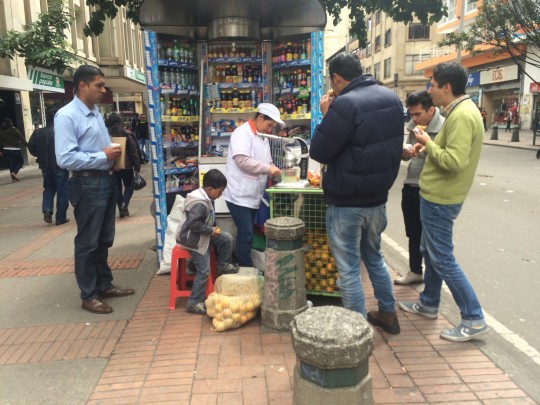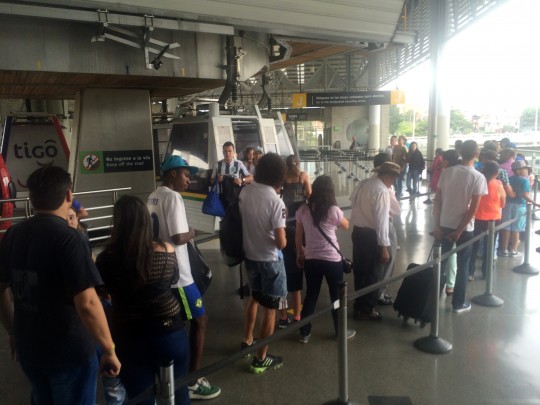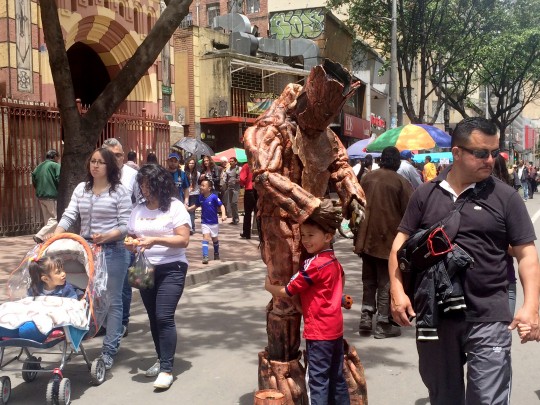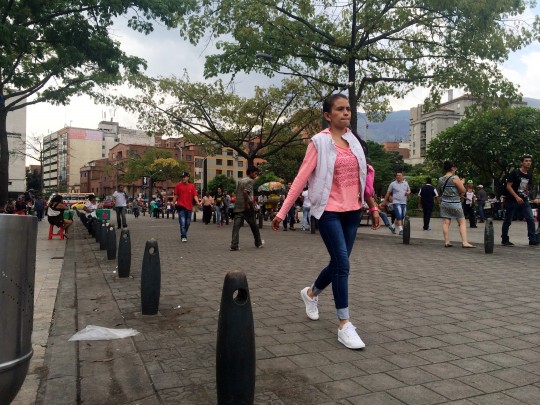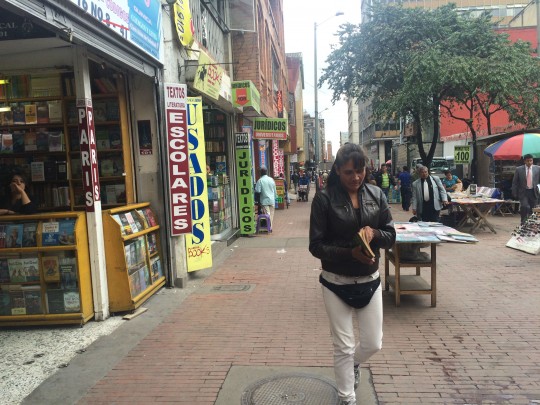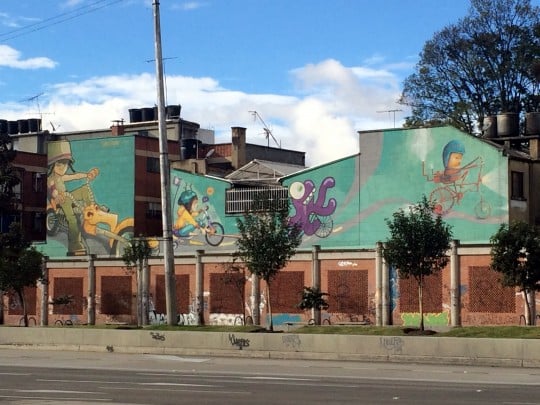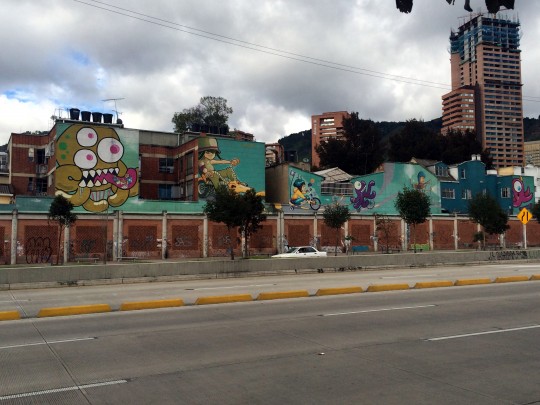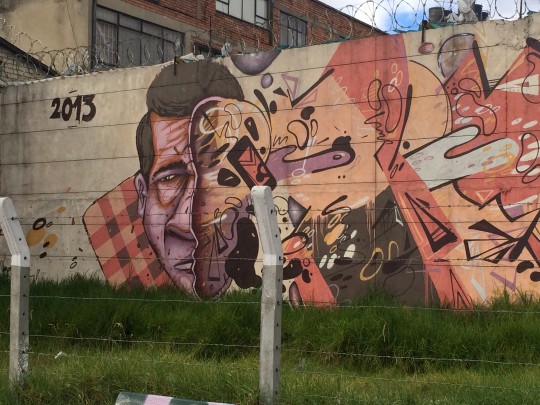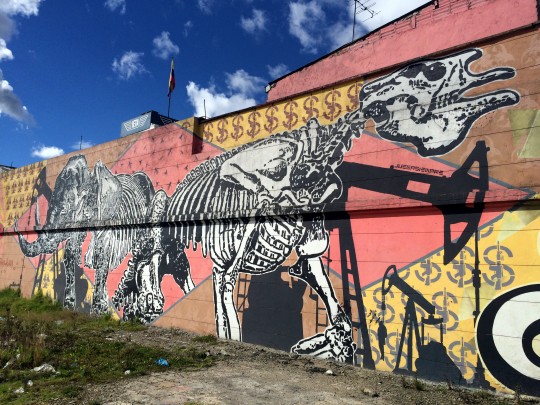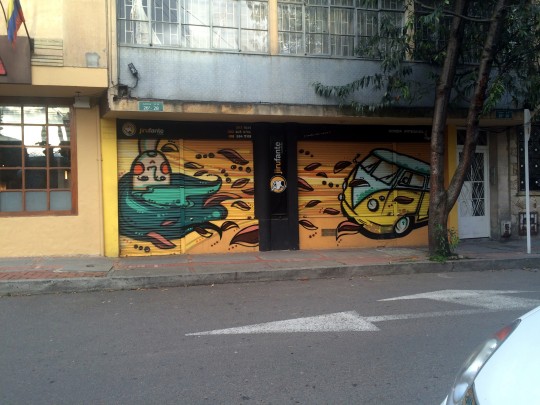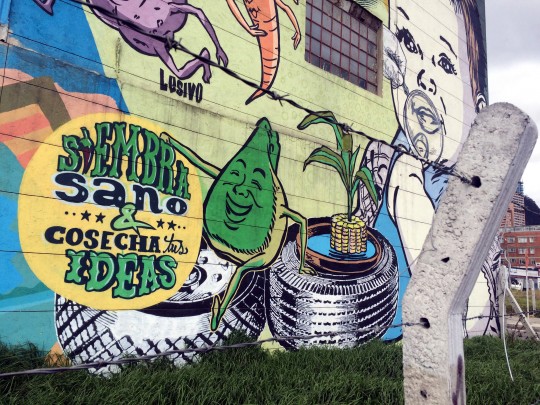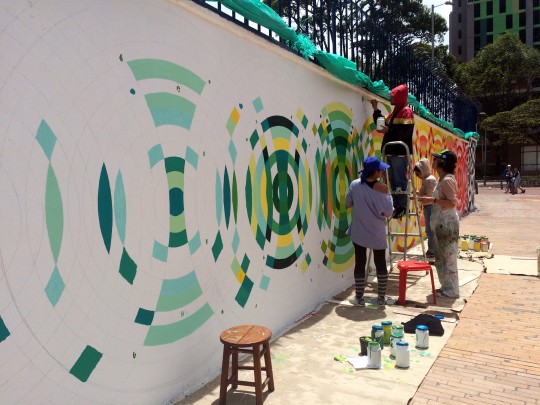
(Click to enlarge. Photos: M.Andersen unless noted)
Second in a two-post series.
It’s a little bit dumb that urbanists in the United States talk so much about Europe but so rarely about South America.
Our southern neighbors, after all, are more like us in big ways. Almost none of South America’s cities have medieval cores; they too were built mostly in the auto age. South America’s national and racial identities are relatively new, like ours are, and diversity and immigration are parts of South American national identities in ways that long-developed parts of Asia, northern Africa and Europe don’t share.
Also, South American cities are laboratories of rapid change. Bogotá, Colombia’s biggest metro area, has added 4.8 million new residents since 1990 and is now approximately the population of Greater London. The only European city that comes close to that sort of growth is Istanbul.
Colombian cities are no more perfect than any city. But on my honeymoon there this summer, I came across lots of neat ideas for building human-friendly streets that were worth bringing back home to talk about.
Here they are.
1) Raised crosswalks
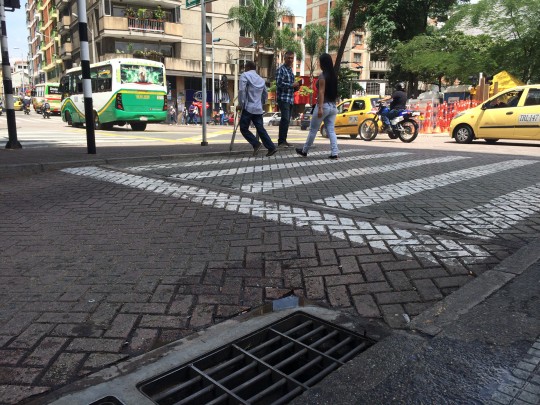
The United States has an organized movement to build more raised bike lanes. (I know because it’s my other gig.) Why doesn’t it have an organized movement to build raised crosswalks?
Raised crosswalks are fantastic.

Just as Colombia has embraced protected bike lanes because they’re the only kind of bike lane with a chance to be respected by people driving in Colombia, Colombian neighborhoods that are working hard on their walkability are building raised crosswalks. They’re expensive to install, of course. But they work very well, and I don’t know why they’re not more common in the States — outside of Walmart parking lots, that is.
2) Press-on traffic calming
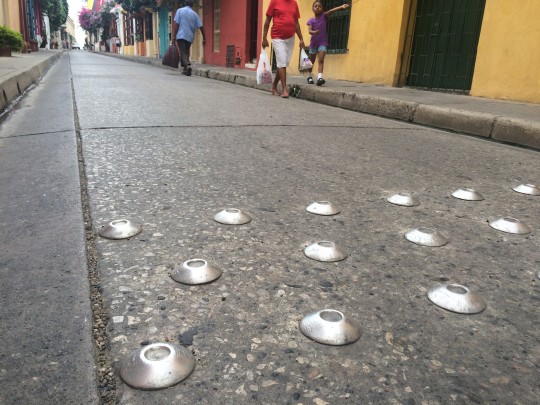
Too broke to pay for textured pavement? Yeah, so is Cartagena. But these simple pavement studs do a similar job well enough for much less.
3) Bus rapid transit

Speaking of doing the job well enough for much less, Bogotá’s TransMilenio system is as much a triumph as everyone says. After decades of failing to build a public rail system — can you imagine a city the size of Chicago with no major rail transit? — Bogotá in 1998 decided to steal a cheaper concept from Curitiba, Brazil. It was a bus line that functioned like a traditional rail line, complete with dedicated lanes, limited stops, highly visible stations, frequent all-day service, big bendy vehicles and payment before boarding.
The much-imitated TransMilenio would be worth very little without its dedicated lanes, just as the Portland bus rapid transit lines Metro is planning now on SE Powell and Division and considering for SW Barbur won’t do much good if their buses still have to sit in traffic.
It’s because of TransMilenio’s bus lanes that you’d be a fool to try to get around Bogotá by car unless you had to. TransMilenio’s ridership shows it. Its stations pack to crush capacity each day with riders of every class.
TransMilenio has downsides; even its well-built Volvo buses are bumpier than rail cars would be. But when BRT works, it works. It’s great that many U.S. cities are figuring this out.
4) Fold-out storefronts
Aren’t these clever? Much like food carts that turn Portland’s former parking spaces into economic engines, each of these metal pillars folds neatly out into two sidewalk shops (one on each side) during busy times of day.
Admittedly, most of them seemed to be selling the same 39 or so items, and the whole system depends (like much of the Colombian economy) on many people being willing to not make a lot of money per hour. But as space-efficient ways to bring commerce and convenience to a street, these are terrific.
5) Gondola transit
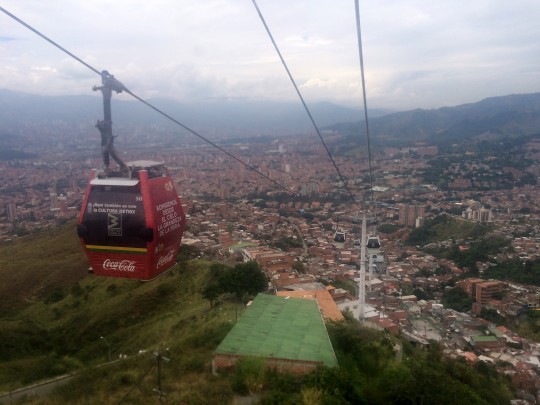
What a good idea.
Portland, of course, has an aerial tram connecting the South Waterfront to Oregon Health and Science University, and when I heard that Medellín had a gondola system I pictured the same thing: a big floating room going back and forth every few minutes with a dude inside shouting “la cabina se moverá cuando pasamos de la torre” all day, every day.
Medellín’s Metrocable system, introduced in 2004, is different, in a way that I hadn’t wrapped my head around until we used it: the cars are tiny and arriving constantly. Portland’s tram works well for its job, but there is a big psychological difference between a 79-capacity car every three minutes and an eight-capacity car every 15 seconds. It’s basically the difference between breaking stride and not breaking stride.

Another huge thing: Because Metrocable cars aren’t individually staffed, Metrocable can offer 15-second headways without high operating costs. At least until the self-driving bus is perfected, the best bus system in the world will never be able to arrive as frequently as Metrocable. All those bus drivers would just be too expensive.
As it is, Medellín (a city about the population of Portland but much denser) is able to maintain a public transit network with five lines of fast-moving, constantly arriving vehicles linking 13 stations. It’s a perfect add-on to the city’s larger rail network, and it’s allowed Medellín to leap gracefully to the far side of a mountain, into another valley, and build a transit-oriented middle-class suburb up the side of a second mountain:
6) Routing ciclovía through a pedestrianized area

Colombia’s No. 1 claim to fame in the U.S. biking world is the weekly open-streets festival it calls Ciclovía. We got to see two in Bogotá. I’d expected them to offer something lots of us have yearned for from Portland’s Sunday Parkways: the joy of riding car-free on big commercial streets. But I didn’t realize that it’d also offer a related combo: an open-streets event on a street that is already car-free almost all the time.

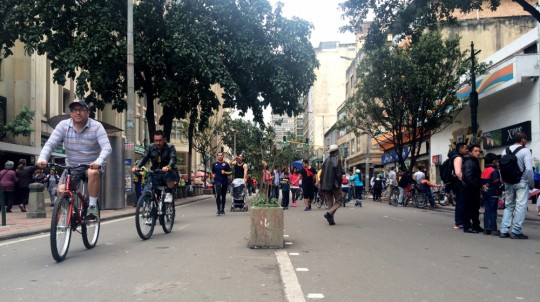
That was the case on Carrera 7 in central Bogotá. By pedestrianizing a network of streets throughout the city, the weekly festival makes this street even livelier than it usually is — notably by opening the streets up to free, minimally restricted commercial uses. Given the flow of people pouring past, Bogotanos came up with hundreds of ways to bring the streets to life, from living statues…
…to pay-to-jump trampolines…

…to sidewalk sales of every variety (the sign on the right says “clothing for your pet,” which rang familiar)…
…to musical performances in a bus shelter…
(I think there may be some disagreement within this band over whether the guy on the right is supposed to be the frontman or the guitarist with mystique)
…to games for kids. (And looking back at this picture, I have to say: those are some legit Bogotá leg muscles.)
7) Pedestrianized spaces in general
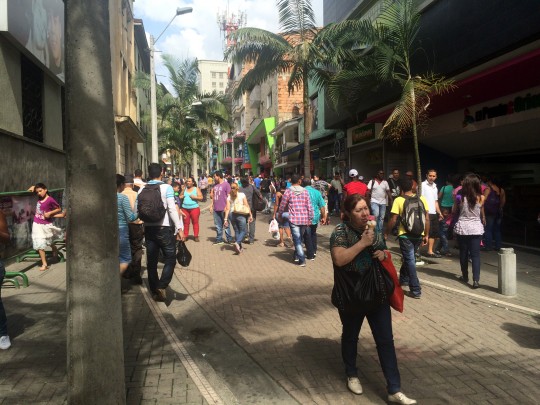
To run Sunday Parkways through a pedestrianized space, of course, we’d need some pedestrianized space. And with a few small exceptions, Portland is sadly lacking in it.
To be sure, pedestrianized areas are harder to make work in a city as rich as Portland, where most people own cars. In any case, I was impressed by the number and liveliness of city streets in central Medellín and Bogotá that are either closed to cars…
…or built and used in a way that made it clear that motor vehicles were guests.
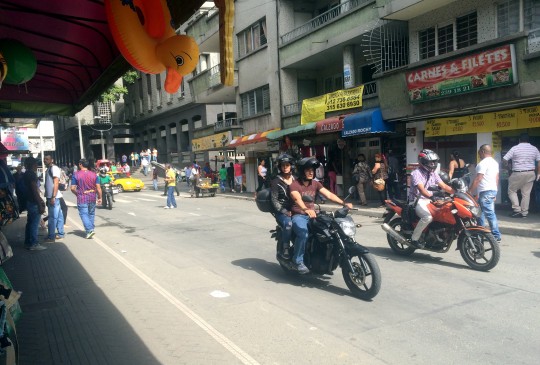
The street below offered several continuous blocks of bookstores, essentially creating an open-air Powells under multiple owners.
8) Private buses
This isn’t unique to Colombia; lots of developing and middle-income cities are flooded with private buses sometimes called colectivos. The one above, in Medellin, was wrapped in ribbons to celebrate the Feast of St. Christopher, patron of bus drivers.
Here’s the thing about Colombia’s private buses: they spew thick pollution, weave unpredictably between lanes, and are frequently disintegrating inside. They lack unified fare systems or reliable schedules, and in some of them the driver is also the fare collector, which means he’s trying to make change while zooming down the street. This is dangerous.
And yet … the fares are cheap (about 50 cents) and the buses are arriving all the time.
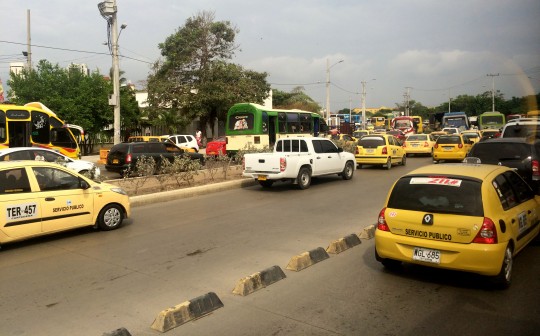
Above is a typical scene from a thoroughfare in Cartagena, which unlike Medellín and Bogotá hasn’t yet attempted to replace its private buses with public ones. Unlike the impenetrable database of numbers you have to memorize to understand, say, TriMet’s system, Colombia’s private buses are models of usability, their windshields colorfully marked with their route and destinations.
Here’s a U.S. transit rider’s dream: the best of both worlds. Private bus operators would pay TriMet for a set of basic services: curbside access to bus stops, a unified fare system and a shared arrival-tracking server. Then they could get licensed to run whatever routes they like during whichever hours they could make money. The public could keep operating our own system, or just subsidize certain routes and riders.
Portland saw a private bus boom during World War I, but streetcar companies convinced the city to drive the upstarts out of business. Could private mass transit work again? We’ll never know until we stop making it illegal to try it out.
Advertisement
9) Prefab half-benches

Want to give people a place to sit, but not sleep? These metal pipeworks are all over Medellín’s rail stations. I expect the shipping costs are pretty high, sadly.
10) Linear parks

(Photo: Amnerys Marieta Pérez Coronado)
I didn’t manage to get any good pictures of my most surprising discovery in Colombia, because we were in a rush to catch a plane. It was a miles-long chain of seemingly Dutch-quality bikeways along a river in Montería, a city of 1 million near the Caribbean coast that I’d never heard of. The bike paths transitioned seamlessly into protected bike lanes through a major commercial district and ran all the way to the airport. We were there near the end of a Friday rush hour, and they were packed with riders.
I later figured out that we’d accidentally stumbled across the Ronda del Sinú, the longest linear park in Latin America and the centerpiece of the bike network in Montería — a city that apparently has a biking mode share of 12 or 13 percent, making it one of the most important bike cities in the Western Hemisphere.
All of which is especially exciting because Montería would be the hottest bike-friendly city I know of. Year round, its average highs are in the 90s, its lows in the 70s. (Bogotá, by contrast, has the dry air and drizzly cool of Portland, Amsterdam or Copenhagen, thanks in its case to its altitude.) If I ever get back to Colombia, Montería will be at the top of my list.
11) Public murals

OK, this final item is not directly transportation-related, though public art definitely helps make a city feel more human-friendly. And of course I’m far from original in praising Bogotá’s street murals.
But still: they are spectacular.
This series seems to have been a collaboration between two or three artists along a major street.
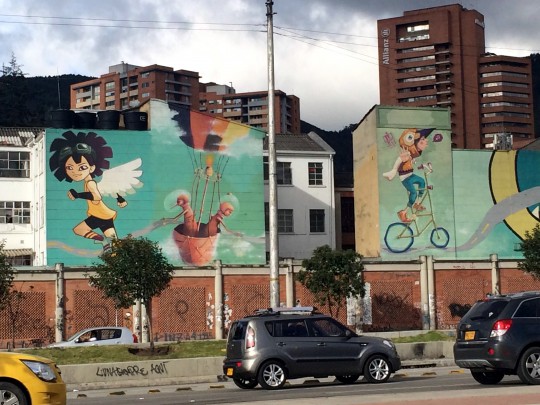
Here’s another impressive sequence, from left to right:
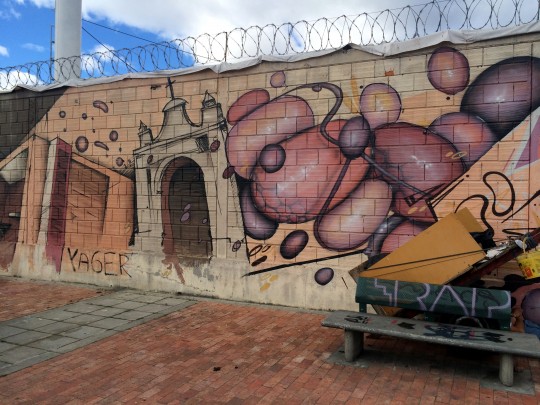
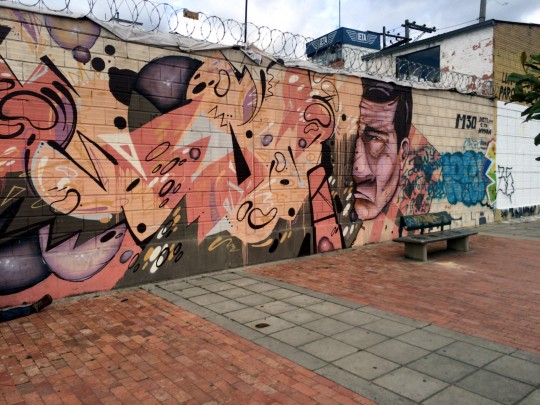
In some cases, Bogotá’s murals are a sort of public education: ways to pass on pieces of the city’s history and values to the millions who’ve arrived only recently.
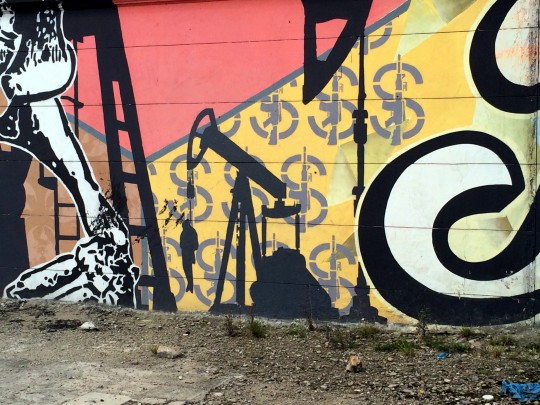
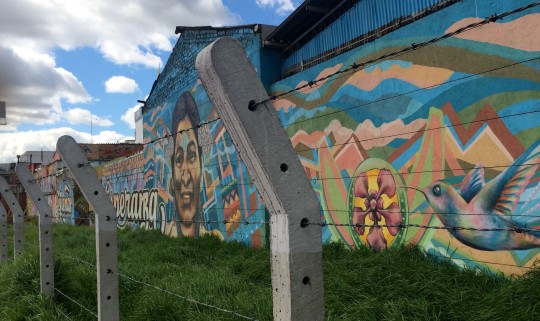
In other cases, they’re just memorable decorations for the garage door of a closed storefront.
On our last days in Bogotá, we came across this mural a few times in various stages of installation:
More than anywhere I’ve been in the States or Europe, Colombia’s cities are bursting with change. There’s a construction project around every third corner. This isn’t all good (I was amused to find a horrified column about “uncontrolled urbanism” in the Medellín equivalent of the Northwest Examiner) but it gives you a palpable sense of a country on the rise. Armed with ideas like these, Colombia very clearly is.



